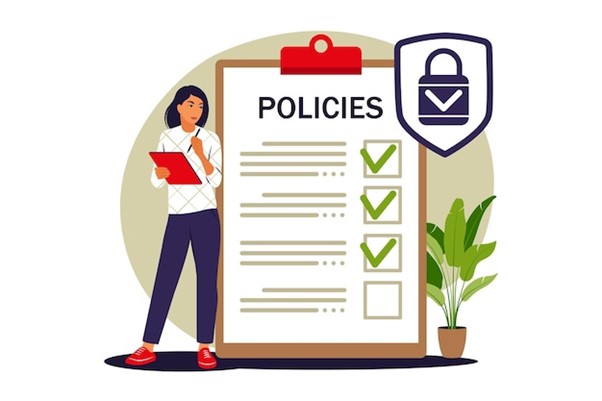Organisational Policy and Procedures
New- Policy Tracking and Reporting for Compliance and Efficiency Gains
We’ve just introduced Policy Tracking and Reporting for members of the Police Place’s online policy service.
This new function provides managers with valuable information about the views and use of organisational policies and procedures. It also offers evidence of compliance that organizations can use for audits and assessments, ensuring adherence to the Social Sector Accreditation Standards, Ngā Paerewa Health and Disability Standards and other relevant laws and regulations.
In this post, we’ll cover what Policy Tracking involves, its benefits and how to impelement and use this new function.
If you are a member of the online policy service let us know if you want access to the new function. If you are not yet a member, contact us NOW to discuss joining.
What is Policy Tracking
Policy Tracking reports on the use and views of an organisation’s policies. It tells you which of your policies have been viewed and by whom, within chosen timeframes.
Here’s an example of a Policy Report:

- The report can be specific to a staff member or group of staff.
- It can be specific to policy pages.
- It can consider policy views within your chosen timeframe. .
The Benefits
We added this function because clients were asking for it. Policy Tracking and Reporting will bring the following benefits:
- Enhanced Compliance: Policy tracking provides records of policy views that can be used to evidence compliance with policies and laws during audits and inspections. This transparency can protect an organisation from liability and shows a proactive approach to compliance.
- Risk Management: Ensuring that all staff have viewed and understood critical policies like the Code of Conduct, Health and Safety, and Complaints reduces the risk of non-compliance with laws and regulations and harmful consequences.
- Operational Efficiency: By automating the tracking of policy views, organisations can save time and resources that would otherwise be spent manually monitoring compliance.
- Improved Transparency and Responsibility: Policies should be a single source of truth for an organisation. Policy Tracking reminds staff of the need to keep themselves informed about revisions and updates to policies and helps steer organisational members in the same direction.
- Continuous Improvement: Policy Tracking will provide information that can help investigate workplace incidents or complaints and plan training and service improvements.
Beware of privacy implications

Policy Tracking involves handling staff personal information, so applying privacy safeguards is crucial:
- Inform Staff: Before implementing the Policy Tracking function, let staff know you are going to do it and the purpose behind it.
- Anonymise Data: When using the Tracking data for audit and assessment purposes, remove identifying information. Anonymised and aggregated data provides as good evidence of policy use as identifying data.
- Restrict Access: Only allow authorised personnel to access Tracking data to ensure personal information remains secure. Usually, access will be confined to management.
- Limit Data Use: Tracking data must not be used for any purpose unrelated to the reason it is gathered unless allowed by law.
- Transparency: Inform staff they can request access to the tracking data you collect about their access and use of policies.
Limitations of Policy Tracking
We’ve previously posted about the limitations of a compliance-focused approach to policy. The limitations apply to the new Policy Tracking function.
While policy tracking tells you if a person has looked at a policy, it does not tell you whether they understood the policy or whether the policy has been applied. That’s where our online courses come in. Check them out here. They are short online courses that support members and non-members of the online policy service in understanding and applying policies and procedures in a range of areas.
Conclusion
The new service for tracking staff views of policies and procedures promises many benefits for our online policy members. It will support our policy clients in building service quality and efficiency, reducing risk, and fostering a culture of transparency and responsibility.
If you want to use the Policy Tracking function and you’re one of our online policy service members, then just let us know. If you’re not an online policy service member but are interested in joining, contact us to discuss your policy needs and how we can assist.
Contact us NOW to enhance your compliance and operational efficiency with our new Policy Tracking and Reporting service.
Fostering Organisational Justice: Strategies for Workplace Fairness and Wellbeing
Why You Need a Comprehensive AI Policy
Artificial intelligence (AI) is becoming integral to many industries in Aotearoa, including social and health services. While AI offers benefits, it also poses significant risks that need to be addressed through comprehensive AI policies. That’s why we at the Policy Place have recently released our new AI policy for our online policy clients.
In this blog we consider the importance of having an AI policy in social and health service agencies, the risks of not having a policy and some of the key things to cover in an AI policy for community, social and health services. For our previous post on AI use in social and health services see here.
The Rise of AI in Workplaces
Artificial intelligence is no longer a futuristic concept; it is actively shaping how organisations operate.
The 2024 Work Trend Index Annual Report from Microsoft and LinkedIn released in May this year, found that AI is prevalent in the workplace worldwide. Key findings highlighted that AI use is pervasive in global workplaces and that AI use is beneficial in terms of time-saving, efficiency gains and adding to the enjoyment of work.
However, the Report also identified pervasive risk with AI use; that, in workplaces without an AI policy or other guidance 78% of employees had taken things into their own hands and were bringing and using their own AI tools at work.
The Risks of AI Use without AI policies and guidance include:
- Data Security Risks: AI systems can be vulnerable to cyber-attacks, which can lead to data breaches and loss of sensitive information. Without an AI policy, staff may input personal information and sensitive organisational data.
- Ethical and Legal Risks: AI use can lead to ethical dilemmas and legal issues, such as unauthorised use of personal data, breach of copyright and AI-driven decisions that are biased and breach human rights.
- Operational Risks: Relying on AI without proper oversight can lead to operational inefficiencies, errors, and potential harm to clients.
- Cultural Risks: AI data may not be sufficiently responsive to diverse cultural contexts and needs of different communities. Without proper AI policies and guidance, AI use risks undermining important cultural practices and values, particularly those protected by Te Tiriti o Waitangi.
The Importance of an AI Policy
An AI policy is basically the starter or minimum for a workplace to address some of these risks:
- Ensuring Ethical Use of AI: An AI policy helps ensure that AI tools are used ethically and responsibly. This is crucial in social, community and health services, where decisions made by AI can significantly impact individuals’ lives and well-being.
- Protecting Client Privacy: An AI policy guides how staff should use AI in alignment with the Privacy Act 2020 and privacy policies. This is particularly important for social, health and community services dealing with highly sensitive and confidential data.
- Maintaining Accountability: Clear guidelines within an AI policy guide staff on how they may use AI in their decisions and their duty of reasonable care. This is particularly important in health and social services, where transparency and trust are paramount.
- Preventing Discrimination: An AI policy will include checks that staff must do on AI generated data before relying on it and prohibitions against reliance on unbiased and unverified data.
- Honoring Te Tiriti o Waitangi: AI policies must recognise and protect Treaty of Waitangi rights. This includes ensuring that AI use does not disadvantage iwi and whānau Māori that health and community services work with and that data sovereignty and cultural considerations are respected.
Strategies to support an AI Policy
An AI policy is just the beginning for a workplace wanting to use AI. Like any policy, your AI policy needs to be backed up by a strong implementation strategy that includes the following
- Regular Audits and Assessments: Conduct regular audits of AI systems to ensure they operate as intended and comply with ethical standards.
- Training and Awareness: Provide training for staff on the responsible use of AI and raising awareness about potential risks and ethical considerations.
- Bias Mitigation Strategies: Implement strategies to identify and reduce biases in AI systems eg data checking, surveys and if affordable, bias detection algorithms.
- Robust Security Measures: Apply strong cybersecurity protocols to protect AI systems from threats and ensure the integrity of data.
- Transparent Decision-Making: Ensure through training and policy that staff responsibilities for AI use are clearly articulated, and AI-driven decisions are transparent and explainable.
- Cultural Safety and the Treaty: Use strategies like training, bias detection systems and iwi/community consultation to ensure that the rights of tangata whenua under the Te Tiriti o Waitangi are respected and protected with AI use.
Conclusion
AI brings benefits as well as risks especially for the social, community and health services we work with. To get the most out of AI and help protect against the risks, an AI policy is a “must.” It’s arguably the beginning of a new policy era when, in response to rapidly evolving technology, we need to revise and evolve policies at an equally fast pace.
Proposal to repeal section 7AA – a BIG Mistake!
The Waitangi Tribunal has just released its Interim Report on the Minister for Children's proposal to introduce a Bill to Parliament to repeal section 7AA of the Oranga Tamariki Act 1989. The Minister's proposal was outlined in a Cabinet paper lodged with the Cabinet Social Outcomes Committee on 27 March.
Reading the Tribunal report, it's clear that there is no sound reason for repealing section 7AA and that no Bill to enact the repeal should be introduced to Parliament.
For those who don't have time to read the Tribunal Report and who want to know what "all the fuss" is about, we outline below "the basics" of the Minister's proposal to repeal along with the Waitangi Tribunal responses. We begin with an outline of section 7AA of the Oranga Tamariki Act.
Section 7 AA
Section 7AA was enacted into NZ law in 2017 along with a number of other reforms. The broad reform aims were to improve outcomes for children in the statutory care and protection and youth justice systems and reduce inequities between Māori and non-Māori in these systems. (See Expert Panel Final Report Investing in New Zealand’s Children and their Families Investing in Children Programme, December 2015)
Section 7AA guides the Chief Executive (CE) of Oranga Tamariki in its duty to give effect to Te Tiriti of Waitangi, particularly in relation to the Treaty obligations concerning partnership, equity and tino rangatiratanaga. Key provisions are that:
- Oranga Tamariki's practices, policies and procedures must have regard to mana tamaiti (tamariki) and the whakapapa of tamariki Māori and to the whanaungatanga responsibilities of their whānau, hapū, and iwi:
- The CE must seek and respond to invitations to enter strategic partnerships with iwi and Māori organisations.
- The CE must report publicly on the fulfilment of their duties under section 7AA including on the impact of the steps they have taken to improve outcomes for Māori.

What the Minister of Children is proposing and the Tribunal's response
The Minister of Children's proposal for legislation to repeal section 7AA rests on a number of suppositions/proposals outlined below.
Proposal
The problem is that tamariki are being moved from stable and loving placement for cultural reasons rather than because of their needs and interests. Section 7AA is the cause.
Tribunal Response
The Tribunal accepted that sometimes wrong decisions can be made. However, no evidence was presented that section 7AA was to blame. The Tribunal and Oranga Tamariki indicated that wrongful removal of children from placements reflects poor social work practice at an individual level.
It's also relevant here that section 7AA is a Pou or cornerstone of the Oranga Tamariki Act 1989. Unlike Parts 2 and 4 of the Act (provisions to guide care and protection and youth justice interventions), section 7AA doesn't guide decisions about the placement of a child.
Proposal
Section 7AA means that a child's best interests are not prioritised in case decisions and are overrode by a "misplaced" concern with cultural identity.
Tribunal Response
This is not true. In fact, evidence presented to the Tribunal indicated the opposite and that s7AA has resulted in material gains for young people in care.
Oranga Tamariki reported that tamariki now have more opportunity to connect with their culture and develop a sense of belonging. This protects against adversity and supports long-term well-being and is in children's best interests.
Te Puni Kōkiri submitted to the Tribunal that children's cultural needs must feature in any "best interests" consideration for a child because addressing cultural needs is essential to a young person's wellbeing and success.
Proposal
Decisions about children should be "colour blind".
Tribunal Response
The view that all children should be treated the same regardless of ethnicity reflects out-dated and now widely criticised views of equality.
More than 40 years ago, in the landmark Pūao-te-Āta-tū report this view of equality was criticised for having contributed to inequities between Māori and non-Māori in the care and youth justice systems. It is a woefully inadequate answer or guide to addressing the complex dynamics and impacts of colonisation.
Reducing equality to same treatment also fails to recognise that Māori, including tamariki, have particular rights under the Treaty including the right to live as Māori in Aotearoa.
Proposal
That section 7AA is causing harm to children and diverting people from a child-centric approach.
Tribunal Response
There is no evidence that s7AA is causing unsafe practice and harm to children.
Rather, evidence presented at the Tribunal indicated that the repeal of s7AA itself is likely to cause harm in a number of ways:
- It will undermine the trust and confidence that has been slowly built between Oranga Tamariki and iwi/Māori
- It will impede and undermine prevention and early intervention work
- Tamariki may be more exposed to harm
- Work to reduce inequities between Māori and non-Māori in care and youth justice is likely to slow down
- There will be adverse impacts on the safety, stability, rights, needs and long-term wellbeing of children involved with Ministry.
In conclusion
It seems incomprehensible that the Minister of Children wastes public time and money on a proposal lacking merit and integrity. It doesn't address the problem she's concerned with. If it progresses to legislation it is likely to cause harm.
It rides roughshod over the good faith and hard work that has been done by iwi/Māori and her own Ministry to build relationships and processes that will achieve good outcomes for children and young people in care.
Let's hope that now, with the benefit of the Waitangi Tribunal's Report, the Minister will realise her mistake and look at how she can achieve more for children in care through closer working with iwi and Māori organisations.
A Comprehensive Guide: Identifying and Addressing Workplace Stressors
In today’s workplace, you can’t just focus on physical hazards. Psychosocial hazards like work stress, conflicts, harassment and traumatic incidents must also be considered. Mental wellbeing not just physical wellbeing of staff has to be the goal of a supportive workplace.
At the Policy Place, we reflect this focus for members of our online policy service throughout our health and safety policy suite. But policy isn’t enough. Within any organisation or business the first important step to prevent mental harm and injury is to identify psychosocial hazards.
To help with this, we’ve prepared the following Action Plan that is based on the Model of Practice for Managing psychosocial hazards at Work produced by Safe Work Australia. Follow the steps in it and you’ll be able to identify key hazards in your workplace warranting management via your health and safety policy and procedures.
With this information, you’ll then be able to work with your staff to assess and mitigate risks like burnout, high turnover, and psychological harm and achieve a supportive work environment where both morale and productivity are high.
Action Plan: Identifying and Addressing Workplace Stressors
1. Conduct Comprehensive Hazard Identification 🔍
Identify all reasonably foreseeable psychosocial hazards within your business or community service.
2. Recognize Cultural Hazards:
🌐 Consider cultural factors that may contribute to psychosocial hazards, such as organisational norms, cultural diversity, values, messaging and communication styles.
3. Consultation with Workers: 🤝
Engage workers in the hazard identification process, including Health and Safety Representatives (HSRs) if applicable.
4. Use Surveys and Tools:
📊 Employ surveys to gather information from staff, HSRs, supervisors, and members of the management team.
4. Observe Work and Behaviors:
👀 Observe the workplace environment, work practices, and interpersonal interactions.
5. Review Available Information:
📋 Review records of injuries, incidents, complaints, workplace inspections, staffing decisions, notes from exit interviews, absenteeism, policies, and more.
6. Identify Trends:
📈 Analyse collected information to identify trends in hazard occurrence (eg retention versus attrition in areas; absenteeism).
7. Establish Reporting Mechanism:
📝 Establish and promote ways for workers to report hazards, ensuring privacy and anonymity where possible.
8. Encourage Reporting:
📣 Address common reasons for underreporting and encourage workers to report hazards through various accessible channels.
9. Act on Reported Hazards:
⚠️ Take reported hazards seriously and implement appropriate control measures.
10. Adapt Reporting Systems Proportionally:
🔄 Tailor reporting systems to the organization’s size and risk profile.
Learning v Compliance Reporting and Tracking
In organisations of many types, compliance reporting and tracking have led to a compliance-driven approach to operations.
However, a paradigm shift is now underway in the not-for-profit sector. Having long struggled to get staff on board with compliance and policy implementation, many nonprofit agencies are shifting from a compliance-driven approach to a learning-focused one.
In this blog, we’ll explore why a learning approach to compliance is superior to compliance tracking and reporting for an organisation that is required to meet regulations and standards like the Social Sector Accreditation Standards, Community Housing Performance Standards and Ngā Paerewa Health and Disability Service Standards.

1. Fosters a Culture of Continuous Improvement
Unlike compliance reporting, which often focuses solely on meeting minimum requirements and is backward looking, a learning approach to compliance encourages ongoing growth and development. By prioritising learning, agencies can foster a culture of continuous improvement, where kaimahi/staff members are empowered to seek out new knowledge, skills, and best practices.
2. Learning approach aligns with non-profit kaupapa
Nonprofit agencies typically have a person/whānau centred kaupapa and value the concept of voluntariness highly. A learning approach to compliance aligns with this, particularly, these short online courses developed specifically for non-profit agencies in Aotearoa. The learning approach to compliance assumes that most people want to meet their obligations. It allows the broadest possible compliance at the least cost both to the agency and to the individual.

3. Compliance reporting and tracking
Agencies accept these as a necessary evil. But compliance reporting and tracking can incentivise fast tracking and a tick-box mentality in an organisation. This can ultimately undermine an organisation’s capacity to improve and build quality of service and reduce staff motivation to innovate and “go outside of the box.” Check out our previous blog about the disadvantages.

4. Drives Innovation and Creativity
Compliance reporting tends to focus on maintaining the status quo—ensuring that existing processes and procedures meet regulatory standards. In contrast, a learning program encourages staff members to think outside the box, explore new ideas, and experiment with innovative approaches. This is facilitated by interactive content like scenarios and quizzes in the Policy Place’s online courses.

5. Supports Engagement and Retention of Kaimahi
Research consistently shows that organisations that invest in employee learning and development experience higher levels of engagement and retention. A learning approach to compliance demonstrates to kaimahi that their growth and professional development are valued as much as the organisation values compliance with external standards. This contributes to greater job satisfaction and loyalty and to an organisation’s ability to retain and attract quality staff.

6. Builds skills and ability to comply
Interactive elements and engagement in online courses can help reinforce key concepts and information retention about requirements for compliance. They provide real-world examples and practical scenarios to illustrate how policy content is applied in different contexts.
This practical application helps staff understand the relevance of policy content and how it translates into everyday practices and decision-making. Ultimately, it means that staff are better prepared for and empowered to meet their obligations.
Conclusion
While compliance reporting serves an important function in ensuring accountability and regulatory adherence, its limitations are increasingly apparent in the nonprofit sector. By embracing a learning-focused approach, nonprofit agencies can unlock a wealth of benefits—from fostering a culture of continuous improvement to driving innovation and creativity.
Ultimately, investing in learning programs isn’t just about checking boxes; it’s about empowering staff, enhancing organisational resilience, and advancing the kaupapa of human service agencies.
Onboarding staff to your policies and procedures
When onboarding staff you need introduce them to some key policies. But can you do that without boring them to death? And can you do it in a meaningful way?
Including policies in your onboarding process is important for many reasons. One, because policies and procedures help you manage risks and guide best practices in your organisation. Secondly, because staff have to know the policies and procedures in order to implement them. Thirdly, because when and if “crunch time” comes, you won’t be able to rely on your policies and procedures if you’ve never taken the trouble to bring them to your staff’s attention.
At the Policy Place, we deal with many clients who talk about the difficulty of getting staff to read and apply policies and procedures. So be assured, you’re not alone with this challenge.
In this post, we’re going to look at two ways staff can be introduced to policies and procedures in an organisation.

Option 1 – You’re killing me
This is when you start a job and are told to sit and read the policies and procedures, then sign off on them once done. In the old days the policies and procedures were a dusty old manual. More modern renditions might be on a Shared Drive or Online Platform like the Policy Place online policy service.
In our online policy service, we aim to make policy content more digestible and accessible. By using an online platform, we reduce the typical density and repetition in organisational policies by using internal and external hyperlinks. We support policy implementation by providing training and other helpful resource links.
The Policy Place gets a lot of positive feedback for its online policies. However, no matter what form policies and procedures take and how hard we try to make them user-friendly, policies and procedures just don’t feature in people’s “top of the pops” list.
Typically, people try and avoid policies. It doesn’t make sense therefore for an organisation to ask new staff to read through their policies and procedures and sign off on them for induction. What an excitement killer!
It’s also a strategy that is unlikely to succeed. Reading policies without having the knowledge or chance to apply the content to real situations and issues, makes it hard to grasp and understand the policy content let alone apply the content.

Option 2 – YES I get it!
A much better way of onboarding staff to policies and procedures is through short online courses that cover off the “essentials” in policy area.
The courses need to be interactive and give staff the chance to apply what they learn to problems and scenarios. The courses are not substitutes for the policies and procedures. But they should address “the essentials” and refer to your policies and procedures.
This type of course is now being offered by the Policy Place.
“Yes, I get it!” is how staff will feel at the end of one of the courses. The courses are interactive and give staff the opportunity through the courses to learn and apply key policy essentials in areas like health and safety and Abuse and Protection to real scenarios and problems. Other courses are in progress.
The courses get rid of the need for staff to have to read through and sign off on policies as part of their induction.
Most of the courses can be completed within 30-40 mins. Once completed, staff are issued with a certificate. This gives you the proof you need as a manager to assure yourself that staff do have the required understanding of key policies and procedures.
Onboarding staff to “Yes I get it”
You can aim high now with your inductions – for your new staff to be motivated and to understand the essentials of your policies and procedures. And with this as your starting point, policy implementation in your workplace looks a lot rosier!
Enrol NOW!
Supporting informed consent
It can be easier said than done regarding the right to give informed consent.
This right is particularly prominent in members’ policies covering Privacy, Child Protection and access to health treatment. It is supported by the policy requirement for people to be given information in understandable ways.
But how do we ensure that people understand the information we provide or the form we ask them to sign? There will always be variables. The language, abilities, age and maturity of people we are working with will affect if and how information is understood. So will the nature and type of information and situation in which it is given.
But there are some general steps we can take to assist people to understand the information we give them or want them to know.
Steps to support understanding
Plain language – Use plain and simple language and break down complexity. Avoid jargon and technical terms that can make it difficult for the average person to understand.
Translation – Offer and arrange for interpreters as necessary for verbal interactions; provide a translated version of the agreement, form or other information into the person’s primary language and ensure the translation is accurate.
Make it visual – Use aids such as diagrams, pictures, charts, or illustrations can help convey complex concepts. These can often make it easier for individuals to grasp the content.
Encourage and answer questions – invite questions, answer and provide further clarification as needed.
Allow time – people often need time to digest information gradually, discuss it with others and time to come back to you to discuss.
Documentation Offer a copy of the written form or agreement to the person in advance so that they can review it at their own pace and come prepared with questions.
Accessibility Support Sse accessible formats and make provisions for Braille, large print, and digital text for screen readers, if necessary.
Simplify – For complex information or if an agreement or form contains intricate or lengthy clausesbreak them down into simpler parts, explain each part separately and check understanding as you go.
Make it real – Offer real-life examples or scenarios to help make the information real and to show what it might mean in practice. In this way, abstract concepts become much more tangible.
Proving Informed Consent
As a members of the Policy Place online service, most of you are subject to external audits and checks. It is therefore important that you document – the steps taken with people to assist their understanding of terms, information, agreement and to properly support them to make informed decisions.
There are many other aspects to the Informed Consent policy that need to be evidenced in individual files. But being able to show that staff are taking the steps needed to ensure people’s understanding oof information, forms etc is an important start.
Co-Governance in your organisation
Co-governance is a misunderstood and much-maligned concept in Aotearoa/NZ. Although the current government does not support it as the basis for our health system, co-governance will continue to be of interest to organisations committed to bicultural and Treaty-based practice.
At the Policy Place, many of our clients and online members are deeply committed to Te Tiriti o Waitangi. In this post, we consider some governance and organisational arrangements to reflect this commitment and how policies and procedures can help.
Constitutional options for co-governance
Co-governance refers to an equality model of decision-making. It gives practical effect to the Te Tiriti undertakings of good governance, honourable partnership and protection and respect for Tino Rangatiratanga of iwi, hapū.
There are different models of co-governance. See here and here for more.
In a business or social or health service context, co-governance arrangements might involve Constitutional requirements for:
- the appointment of an equal number of Tangata Whenua and non-indigenous/Tau Iwi to a Board or other governance structure
- all or some decisions to be referred and approved by Māori and Tau Iwi caucuses
- parallel processes for Māori and non-Māori to make decisions, collaborate and access services
- respect for the values, tikanga, reo and other taonga of Māori/mana whenua
- kaupapa Māori – by Māori for Māori agency
- recognition of He Whakaputanga o te Rangatiratanga o Nu Tireni/The Declaration of Independence, Te Tiriti o Waitangi and NZ law
- explicit recognition and encouragement for liaison between Kaupapa Māori, iwi-based and mainstream services
- other arrangements as agreed between an organisation and mana whenua.
Policies and procedures to support co-governance
If you don’t have co-governance reflected in the Trust Deed or constitution for your agency, a Te Tiriti o Waitangi policy can be a great way to reflect and support a Treaty-based approach. See here for ideas on what can be covered in Te Tiriti o Waitangi policy.
Other policies and procedures to help give effect to Te Tiriti o Waitangi will include those addressing Diversity, Equity and Inclusion policies; Board Membership and Recruitment policies for Board and Staff.
Training and Induction for co-governance
The importance of governance and staff induction and training should not be forgotten. These processes will tautoko co-governance and help build cultural competency across your organisation.
Board induction will introduce new Board members to your Trust Deed/Constitutional requirements and the Board’s role in setting the organisational vision and strategy.
Staff induction will include coverage of your organisation’s values and key policies, procedures and documents.
Conclusion
Co-governance can be achieved at constitutional, governance and operational levels of organisations. It’s an important way to give practical effect to the undertaking of Te Tiriti o Waitangi and to steer an organisation in Treaty-based practice.
RiskManagement with the help of good policies and procedures
Risk management is a key reason for policies and procedures – risks like financial mismanagement, accidents, cyberthreats, privacy.
Take a broad view. No need to be afraid of risk. The wider your view of risk the better prepared you can be and the more able and confident you can feel in your business/organisation.
While risks will be unique to your operation, there are also risks that all of us in business need to manage. At the Policy Place, we help organisations manage these risks with online policies that are regularly reviewed and updated and with other strategies like guidelines and checklists.
Some of the common risks for organisations are listed below, with some of the more common policies and strategies to help manage these risks:
Financial Risk Management
- Policy and procedures relating to financial planning and controls
- Fraud and Corruption policy
- Protected Disclosures policy
- Financial Planning and Investment policies
Information Risk Management
- Preventative & Troubleshooting Maintenance Contracts
- Privacy and Confidentiality policy
- Record Management and Archiving system
- Privacy Breach Procedure
- Information Safeguards policy and procedure
Managing Economic & Political Risks
- Media-related policies and processes
- Hazard-management policy and procedure
- Staff and Governance Recruitment Policies and Procedures
- Strategic & Business Planning
- Hazard & Risk Register
Health and Safety Risk Management
- Wellbeing policy and procedure
- Health and Safety procedures including Hazard and Risk Register; Staff Participation
- Induction and ongoing staff training
- Pandemic Planning
- Infection Control policy and procedures
- Cultural Safety and Responsiveness policy and training
- Harassment and Bullying policy and procedure
Service-related Risk Management
- Complaints and Feedback Policy and Procedures
- Performance and service planning and review processes
- Quality Management policy and procedure
- Training and development of staff
- Policies to guide delivery
- Business Continuity Plan








